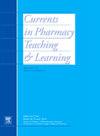Pharmacy students' knowledge of sickle cell disease
IF 1.4
Q3 EDUCATION, SCIENTIFIC DISCIPLINES
引用次数: 0
Abstract
Introduction
Pharmacists have a vital role in sickle cell disease (SCD) management, particularly given the recent advancements in treatment options. Therefore, it is essential for pharmacy students to be knowledgeable about SCD to provide optimal care to affected individuals they may encounter. However, little is known regarding their knowledge of SCD. Thus, the objectives of this study were to: 1) describe pharmacy students' SCD knowledge and 2) determine if sociodemographic factors and previous SCD exposure were associated with their SCD knowledge.
Methods
This cross-sectional study involved first- to fourth-year pharmacy students at a Central Texas university (N = 400). SCD knowledge was assessed using a 39-item survey covering various aspects of SCD (overall and domain-specific scores range: 0–100; higher scores = greater SCD knowledge). Data were collected in September 2024 and analyzed using descriptive and inferential statistics.
Results
Of the 137 participants who responded, 108 completed >75 % of the survey items, resulting in a 27 % response rate. Participants had suboptimal SCD knowledge with an overall mean score of 43.0 ± 19.2. While knowledge was suboptimal (<70) in all aspects assessed, participants were most knowledgeable regarding SCD pain (67.6 ± 31.7) and least knowledgeable regarding pharmaceutical treatment of SCD (32.6 ± 28.2). Race/ethnicity, academic year, previous encounters with individuals with SCD, and receiving SCD course content during PharmD training were associated with SCD knowledge.
Conclusion
Participants had suboptimal SCD knowledge, notably regarding pharmaceutical treatment. Targeted educational interventions such as including and reinforcing SCD course content in PharmD training could better prepare pharmacy students to care for individuals with SCD.
药学学生对镰状细胞病的认识
药剂师在镰状细胞病(SCD)的管理中起着至关重要的作用,特别是考虑到最近治疗方案的进展。因此,药学专业的学生有必要了解SCD,为他们可能遇到的受影响的个体提供最佳的护理。然而,他们对SCD的了解却很少。因此,本研究的目的是:1)描述药学学生的SCD知识;2)确定社会人口因素和以前的SCD暴露是否与他们的SCD知识有关。方法本横断面研究涉及德克萨斯州中部一所大学药学专业一至四年级学生(N = 400)。SCD知识的评估采用了一项涵盖SCD各个方面的39项调查(总体和特定领域得分范围:0-100;分数越高= SCD知识越丰富)。数据于2024年9月收集,并使用描述性和推断性统计进行分析。结果在137名参与者中,108人完成了75%的调查项目,回复率为27%。参与者的SCD知识不理想,总体平均得分为43.0±19.2。虽然在所有评估方面的知识都是次优的(<70),但参与者对SCD疼痛的了解程度最高(67.6±31.7),对SCD药物治疗的了解程度最低(32.6±28.2)。种族/民族,学年,以前与SCD患者的接触,以及在药学博士培训期间接受SCD课程内容与SCD知识相关。结论被试对SCD的认知不佳,尤其是对药物治疗的认知。有针对性的教育干预措施,如在药学博士培训中纳入和加强SCD课程内容,可以更好地为药学学生照顾SCD患者做好准备。
本文章由计算机程序翻译,如有差异,请以英文原文为准。
求助全文
约1分钟内获得全文
求助全文
来源期刊

Currents in Pharmacy Teaching and Learning
EDUCATION, SCIENTIFIC DISCIPLINES-
CiteScore
2.10
自引率
16.70%
发文量
192
 求助内容:
求助内容: 应助结果提醒方式:
应助结果提醒方式:


